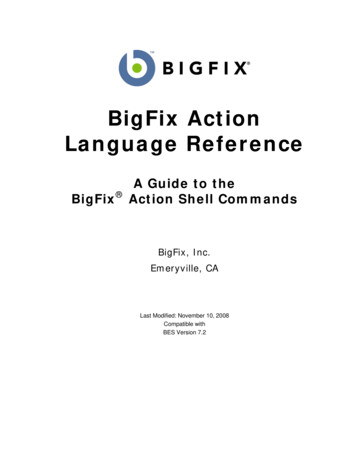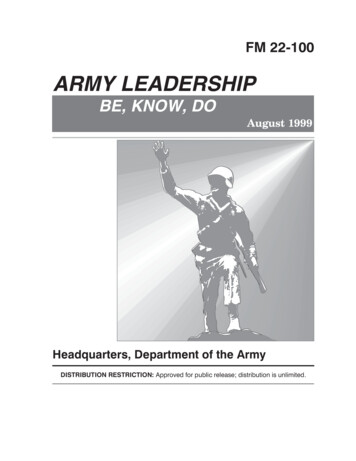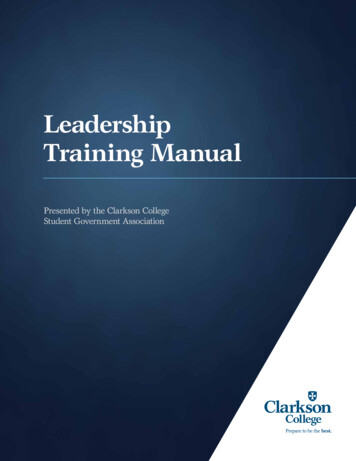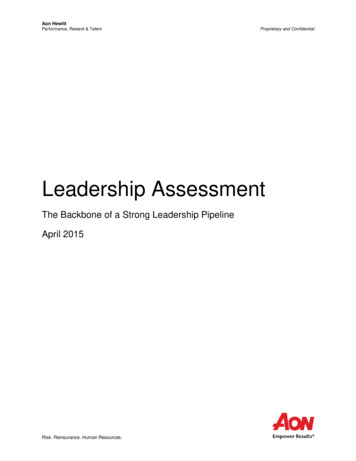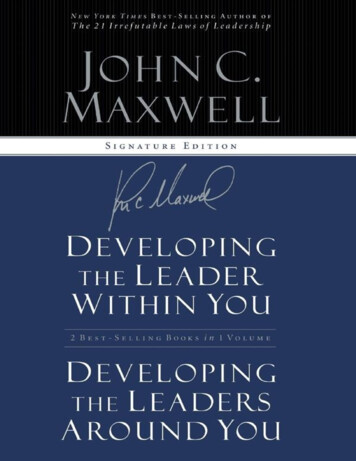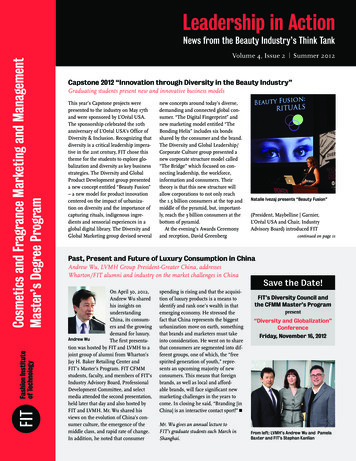
Transcription
Leadership in ActionCosmetics and Fragrance Marketing and ManagementMaster’s Degree ProgramNews from the Beauty Industry’s Think TankVolume 4, Issue 2 Summer 2012Capstone 2012 “Innovation through Diversity in the Beauty Industry”Graduating students present new and innovative business modelsThis year’s Capstone projects werepresented to the industry on May 17thand were sponsored by L’Oréal USA.The sponsorship celebrated the 10thanniversary of L’Oréal USA’s Office ofDiversity & Inclusion. Recognizing thatdiversity is a critical leadership imperative in the 21st century, FIT chose thistheme for the students to explore globalization and diversity as key businessstrategies. The Diversity and GlobalProduct Development group presenteda new concept entitled “Beauty Fusion”– a new model for product innovationcentered on the impact of urbanization on diversity and the importance ofcapturing rituals, indigenous ingredients and sensorial experiences in aglobal digital library. The Diversity andGlobal Marketing group devised severalnew concepts around today’s diverse,demanding and connected global consumer. “The Digital Fingerprint” andnew marketing model entitled “TheBonding Helix” includes six bondsshared by the consumer and the brand.The Diversity and Global Leadership/Corporate Culture group presented anew corporate structure model called“The Bridge” which focused on connecting leadership, the workforce,information and consumers. Theirtheory is that this new structure willallow corporations to not only reachthe 1.5 billion consumers at the top andmiddle of the pyramid, but, importantly, reach the 3 billion consumers at thebottom of pyramid.At the evening’s Awards Ceremonyand reception, David GreenbergNatalie Ivezaj presents “Beauty Fusion”(President, Maybelline Garnier,L’Oréal USA and Chair, IndustryAdvisory Board) introduced FITcontinued on page 11Past, Present and Future of Luxury Consumption in ChinaAndrew Wu, LVMH Group President-Greater China, addressesWharton/FIT alumni and industry on the market challenges in ChinaOn April 30, 2012,Andrew Wu sharedhis insights onunderstandingChina, its consumers and the growingdemand for luxury.Andrew WuThe first presentation was hosted by FIT and LVMH to ajoint group of alumni from Wharton’sJay H. Baker Retailing Center andFIT’s Master’s Program. FIT CFMMstudents, faculty, and members of FIT’sIndustry Advisory Board, ProfessionalDevelopment Committee, and selectmedia attended the second presentation,held later that day and also hosted byFIT and LVMH. Mr. Wu shared hisviews on the evolution of China’s consumer culture, the emergence of themiddle class, and rapid rate of change.In addition, he noted that consumerspending is rising and that the acquisition of luxury products is a means toidentify and rank one’s wealth in thatemerging economy. He stressed thefact that China represents the biggesturbanization move on earth, somethingthat brands and marketers must takeinto consideration. He went on to sharethat consumers are segmented into different groups, one of which, the “freespirited generation of youth,” represents an upcoming majority of newconsumers. This means that foreignbrands, as well as local and affordable brands, will face significant newmarketing challenges in the years tocome. In closing he said, “Branding [inChina] is an interactive contact sport!” nMr. Wu gives an annual lecture toFIT’s graduate students each March inShanghai.Save the Date!FIT’s Diversity Council andthe CFMM Master’s Programpresent“Diversity and Globalization”ConferenceFriday, November 16, 2012From left: LVMH’s Andrew Wu and PamelaBaxter and FIT’s Stephan Kanlian
Alumni Spotlight: Tennille Kopiasz (Class of 2004) Joins Coty Prestige asSenior Vice President, MarketingMs. Kopiasz is the program’s first graduate to attain the level of corporate senior vice presidentProfessor Brooke Carlson satdown with Ms. Kopiasz forthe following Q&A interview.How do you feel about yournew position at Coty?I am thrilled to be a partof such a forward-thinkingTennille Kopiaszorganization with an entrepreneurial spirit, and to be working on such adiversified portfolio of distinguished brands.They respect out-of-the-box thinking and mywillingness to drive change. My best asset rightnow is my ability to look in as an outsider.What has the FIT CFMM degree meant to youpersonally, and how has it affected your career?The program is an amazing learning opportunity, providing exposure to all facets of thebeauty industry with a unique mix of academicand experiential learning. I graduated from theprogram believing that I really could make adifference in the industry as a thought leaderof tomorrow and with the tools to make this areality.What is your proudest accomplishment sincegraduating? While I am passionate about theproducts I work on, I am most proud of thetalented people that have worked with me inmanaging these projects and making themcome to life. There is nothing more rewarding than watching an individual becomeempowered and watching their success, bothpersonally and professionally. When a team isempowered it can feel like magic.What advice can you give young professionals who want a successful career like yours inbeauty? On many occasions throughout mycareer, I was asked to take on a new role, workon a new category, or move to a new division orbrand. At times you need to jump out of yourcomfort zone – you actually might like it morethan you imagined and you would be amazedwhat you can learn.Do you have a personal credo you’d like toshare? Do what you love, and love what you do.If you have not found it yet, keep searching you’ll know when you do. nMs. Kopiasz is a beauty marketingexecutive with experience across prestige,designer, and mass brands, in both globaldevelopmental and executional operational roles, in cosmetics, fragrance andskincare. Tennille joined L’Oréal USAin 1996, and over her 16-year tenure,she worked on various brands, including L’Oréal Paris, Giorgio Armani, RalphLauren, Maybelline and Lancôme. In April2012, Ms. Kopiasz joined Coty Prestigeas the Senior Vice President of U.S.Marketing, responsible for managing anddeveloping the future vision of the U.S.business across their portfolio of brands,including Calvin Klein, Marc Jacobs, VeraWang, Madonna and Jennifer Lopez. Ms.Kopiasz is a graduate of FIT’s Masterof Professional Studies and Bachelor ofScience degree program in Cosmetics andFragrance Marketing and Management. nALUMNI SAVE THE DATE“Brands as Media Companies”FIT MPS Program Alumni Continue to Advance in Their CareersTina-Gaye Bernard (class of 2007) is nowteaching in FIT’s CFM undergraduate program’s Cosmetics and Fragrance Marketingcourse. She is Director of Marketing & SalesDevelopment at Sue Devitt Beauty.Tennille Kopiasz (class of 2004) has movedto Coty Prestige as Senior Vice President, U.S.Marketing.Larisa Jensen (class of 2004) has been promoted to Director, Beauty Industry Analyst atThe NPD Group.Jon Roman (class of 2004) has been promoted to a new role as Vice President, ELC Online,The Estée Lauder Companies Inc.Nicole Howard (class of 2005) has beenpromoted to Director, Corporate GlobalInnovation, The Estée Lauder Companies.Bettina Bamberger (class of 2006) hasmoved to LVMH as Executive MarketingDirector, LVMH Fragrance Brands.Denise Shamlian (class of 2006) has movedto Murad as Director, International Education.Annette Perrotta Saenger (class of 2007)has been promoted to Director, BusinessDevelopment, Coughlan Products LLC.Leslie Harris (class of 2008) has been2Volume 4, Issue 2 Summer 2012promoted to Vice President, Global Marketing,SkinCeuticals, L’Oréal USA.Tenley Zinke (class of 2008) has movedto net-a-porter.com where she heads upCommunications.Vivianna Blanch (class of 2008) has beenpromoted to Vice President, Digital Innovation,L’Oréal USA.Devin Fitzpatrick (class of 2009) moved to J.McLaughlin as Vice President of E-commerce.Bill Hughes (class of 2009) has moved toBare Escentuals as Senior Brand Manager,BareMinerals Makeup.Sarah Ostrower (class of 2009) has been promoted to Director of North America Marketing,Clinique, Estée Lauder Companies.Jessica Rosenthal (class of 2009) has movedto Clinique Laboratories, LLC as Director,Global Skincare Product Development.Jen King (class of 2010) has relocatedfrom Firmenich U.S. to the UK as MarketingManager, Firmenich UK.Liza Rapay (class of 2011) has been promotedto Director, National Programming and SalesStrategies at Clinique Laboratories, LLC.Ildiko Juhasz (class of 2012) has recentlymoved to LVMH as Marketing and TrainingManager, Acqua di Parma, LVMH Fragrances.Special presentation for alumni byL2 Digital Think Tank at House of BumbleWednesday, September 12th, 20125:30 p.m. – 7:30 p.m.ALUMNI ASSOCIATION ANNOUNCES NEW BOARDPresident: Carly Guerra (class of 2010),The Estée Lauder CompaniesVice President: Stephanie Kramer(class of 2011), ChanelSecretary: Renee Ordino (class of 2003),Batallure BeautyTreasurer: Frank Fronzo (class of 2008),The Estée Lauder CompaniesLisa Sequino (class of 2013) has been promoted to Vice President, North America, P&GPrestige Fashion Fragrances, for Hugo Boss,Lacoste, and Celebrity Fragrances.Courtney Das (class of 2013) has been promoted to Global Marketing Manager at Bumbleand Bumble, The Estée Lauder Companies Inc.Alison Cifrese (class of 2013) has moved toCoty as Assistant Brand Manager, Vera WangGlobal Marketing, Coty Prestige.Alexandra Hardyment (class of 2013) has beenpromoted to Assistant Global Marketing Manager,AERIN, The Estée Lauder Companies Inc. n
FIT MPS Alumni Visit All Access Beauty Day at QVC HeadquartersOn April 14th, 2012, a select group of alumnitook a field trip and visited the global headquarters of QVC in Pennsylvania, during AllAccess Beauty Day. The day featured top selling brands including Space NK, Josie Maran,Mally Rancal, Kate Somerville and Chaz Dean.This was the first insider access trip for FITMPS alumni and was coordinated by association members. QVC management hosted“The best takeaway for me was that thisdistribution channel is key to all futurebusiness as sales platforms are changing with the times so quickly! Even QVCis changing their platforms in order tosynchronize with new technology andconsumer behaviors.”Pamela D’Alessandro (class of 2002)the group, including DianePaccione-Rizzo, Vice Presidentof Cosmetics and Jewelry,and Michaelann Vankirk,Vice President of Sales. QVCkicked off the morning with aprivate tour of the facilities andshared all the business basicsat QVC. The group also had achance to go backstage, view alive taping of a show, and talkwith Mally Rancal about howshe pitched her brand to QVC,giving the alumni an insiderview on what makes her brandFIT MPS alumni outside QVC Headquartersa success. Not only was thisan opportunity to enhance thenetwork. The alumni association looks forwardknowledge base of this channel, it also proto more professional development opportunivided a chance for the alumni to reconnect andties of this nature in the future. nMentee-Mentor Experience Spotlight: In Their Own WordsAndrea Reichert (class of 2013) and Kory Marchisotto (class of 2009) share mentor/mentee experience and learning at BPI sales meetingAndrea Reichert (class of 2013), Sales ProjectManager, Firmenich, attended the BPI SalesConference with her Executive Mentor, KoryMarchisotto (class of 2009), Vice President ofMarketing, Beauty Prestige International. Here,they share their thoughts on this unique experience:Andrea Reichert (Firmenich), MenteeAfter the FIT Executive Mentor Luncheon inFebruary, I was eager to open my mind andsoak in the knowledge of my predecessors. Isent an enthusiastic email to my mentor hoping to meet in the near future. The responseI got surprised and delighted me: I had beeninvited to attend one day of the BPI SalesConference in Atlanta, Georgia.Coming from the fragrance supplier side ofthe industry, typically, I am not exposed to thebrand or sales strategies of my clients. It waseye opening to hear the amount of thoughtand detail involved in the brand strategies andfinancial projections. I admired the courage ofeach presenter who not only offered metrics,but also had to convey the heart and soul oftheir brand.One of Firmenich’s fundamental pillarsis “Think Client.” This experience remindedme that I must love and invest myself in myclients’ brands as sincerely and deeply as theydo. Through this profound understanding ofbrand identities, the fragrance houses can trulyconnect and form a partnership with theirclients.If the morning of the conference was notinspiring enough, a motivational speech onbuilding the success of a career upon the top,middle, and base notes of one’s life could nothave been a better way to wrap up the day.Keynote speaker Matthew Ferrara empowered every person in the room to find successthrough clarity in their goals and aspirations.On my return flight, I took time to reflect onthe following: “What are my short-term andlong-term goals at Firmenich,” “What am Idoing to make these happen?,” “Do I reallybelieve that I deserve success?”These are the difficult questions that wewere asked to answer in writing. To visualizeyour goals as written words makes them realand tangible. No doubt these questions willform the cornerstone of my mentorship. I ameager to see how my answers differ betweennow, Capstone and graduation.Kory Marchisotto (Shiseido), MentorWhen I received Andrea’s invitation tolunch, organizing the Sales Conference wasfresh in my mind and it occurred to me thatI might be able to do her one better. I invitedAndrea to Atlanta for the day to join our conference, meet our team, see how our companyworks, and hear our presentations – one veryspecial one in particular.Matthew Ferrara, a world-renownedFrom left: Kory Marchisotto and Andrea Reichertmotivational speaker and a newcomer to ourindustry, addressed our audience of beautyexecutives with the ease and familiarity ofsomeone who’d spent years behind thefragrance counter. Matthew called upon all ofus to build our “Fragrance of Self.” He taughtus, “we are who we design ourselves tobecome.” His message was at once specific andpervasive, challenging our team to acceptsuccess as their destiny while giving them themotivational tools to do so.As Andrea’s mentor, I have made it my personal mission to provide her with rich, meaningful and memorable experiences. Based onAndrea’s enthusiastic response, I think that forher, this experience was personally inspiring,career-motivating and, if nothing else, an eyeopening introduction to the client side of ourbusiness. nVolume 4, Issue 2 Summer 20123
We are pleased to provide here papers by the three Capstone project teams summarizing their May 17 presentations. Due to space constraints,detailed bibliographies have been omitted here but are available in downloadable versions of these papers appearing in the program’s section ofthe FIT website: http://www.fitnyc.edu/cfmm. These papers are works of the graduating students, and any reproduction or use of this materialrequires their written permission.Capstone White Paper on Diversity and Global Product Development: BEAUTY FUSIONAuthors: Natalie Ivezaj, Team Leader; IldikoJuhasz, Team Co-Leader; Ilana Allegro, MairaArnaudo, Kelle JacobBackgroundAccording to Geoffrey G. Jones, HarvardProfessor and author of the book BeautyImagined, the human desire to attract othersreflects basic biological motivations. In fact,every human society from at least the ancientEgyptians onwards has used beauty productsand artifacts to enhance attractiveness. Acrossthe globe beauty ideals and aspirations vary.However, regardless of culture, economic orsocial status, all women seek to achieve theuniversal beauty truths of a youthful glow,clear skin, healthy hair, and healthy skintone. Harnessing the diversity and richnessof the rituals and ingredients used to pursuethese truths provides us with an opportunityto prompt genuine innovation in the beautyindustry to meet the needs of the diverse globalconsumer.The U.S. ConsumerSince the 1970s, the U.S. beauty industryhas recognized the opportunity to developproducts for the unique concerns of a changingconsumer base. Over the last few decades, theneeds of the minority consumer have evolvedwhile at the same time their purchasing powercontinues to grow exponentially. Within thenext five years in the United States, the LesbianGay Bisexual Transgender (LGBT) buyingpower will reach 790 billion. Likewise, thebuying power of Asian Americans will reach 1trillion, African American spending will total 1.3 trillion and Hispanics will have the highestbuying power of 1.7 trillion. In May of 2012,the U.S. Census Bureau announced thatmore than half of children under age two in4Volume 4, Issue 2 Summer 2012the U.S. are ethnic minorities. This significant shift in demographics means the beautymarketplace will become more complex andfragmented. It will be nearly impossible topredict how consumers will define themselves,and the traditional ‘check the box’ options ofAfrican American, Caucasian, Hispanic mayno longer apply.Global ChallengesOver the next ten years consumer spending in all emerging markets is expected togrow three times faster than that of developednations, reaching a total of 6 trillion by 2020,according to McKinsey & Company. Clearly,the BRIC markets (Brazil, Russia, India andChina) have been recognized as one of the keygrowth drivers in the global beauty market.With the rise of the spending power of BRICconsumers, the beauty industry has movedquickly to respond to the diverse needs ofthese consumers. According to Kline, by 2020,China is expected to surpass Japan and ranknumber two in global beauty sales, followedby Brazil in third place. Russia is expected tobecome the number one market in Europe andIndia is expected to rank third in Asia. But newplayers are quickly arriving on the scene. Justlike the BRIC, complex countries like Mexico,Indonesia, South Korea and Turkey (the‘MIST’) have high growth, large populationsand a rapidly growing middle class. Accordingto Price Waterhouse Coopers, each country inthe MIST is forecast to place among the top15 in annual real growth in GDP between nowand 2050. Is the beauty industry preparedto meet the diverse needs of these diverseconsumers?Urbanization Redefines DiversityEmployment and economic opportunity arekey factors that drive urbanization, attractingpeople from rural to urban areas. As emerging markets continue to grow, large urbancenters will continue to attract people from allwalks of life and are thus redefining diversity.Between 2011 and 2050, the world populationis expected to increase by 2.3 million people,reaching 9.3 billion, of which approximately5.1 billion will be middle class. According tothe United Nations Urban Millennium Report,nearly 180,000 people move into cities eachday and 70% of the entire world’s populationwill live in cities by the year 2050. So, whiletraditional global cities such as New York,London and Paris are already sharing the spotlight with Beijing, Mumbai and Istanbul, citiessuch as Belem, Chongquing and Guadalajaraare ready to exert their influence. Consumersin urban environments are very diverse, ranging from ‘Citysumers,’ who are ever moredemanding, open-minded, economically upand coming and savvy, to the Bottom of theUrban Pyramid (BOUP) dwellers. The BOUPdon’t have middle-class salaries to spendbut still demand innovation tailored to theirunique circumstances, from health issues tolack of space to the need for durability. As bothof these groups are drawn together throughurbanization, the diversity of their needs andpreferences can provide a valuable and richsource of inspiration for product innovation tothe beauty industry.Cultural FusionIn his book The Next Hundred Million:America in 2050, the urban scholar Joel Kotkindescribes the concept of ‘fluid identity.’ Hestates that the U.S. millennial generation– those born between 1982 and 2004 – arenot content to identify with a single cultureor race. This generation presumes culturaldiversity as a normal aspect of daily life. Theyadopt, exchange and experiment with multiplecultural identities. This phenomenon is notlimited to the United States, as technology hasmade it simple for all global consumers to pickand choose those facets of various culturesthey identify with and adopt them as theirown. The influence of this cultural fusion isreadily apparent in the food, fashion and musicindustries.In the food industry, ethnic food trucksare replacing gourmet and specialty storesas consumers are seeking to experiment anddiscover new culinary delights. These trucksare usually manned by ethnic descendants oftheir cuisines and cultures, and possess theability to pass on the rituals and heritage ofvarious foods. Tribal and ethnic influencedfashions dominated the runways for Spring/Summer 2012. In this trend, designers take
inspiration from mixed prints and patternsfrom diverse cultures such as Bhutan andGhana, and create garments that are bold anddistinct, yet wearable. Music fans everywherehave also embraced the idea of fusion ofdiverse musical genres. Rapper Jay-Z’s recentcollaboration with Panjabi MC fused togetherquintessentially New York style hip hop beatswith Bhangra, a lively form of music anddance that originated in the Punjab region inSoutheast Asia. Finally, the rise in experientialtravel is further evidence that consumers areseeking to not just connect with other cultures,but to dive more deeply and experience themfirst hand. With the fusion trend so prevalentin food, music and fashion, how can fusion beincorporated in the beauty industry?natives in body painting rituals. The juice ofthe fruit reacts with skin, staining it a tattoolike blue for up to two weeks. Imagine beingable to incorporate this wonderful ingredientto create more natural hair dyes and mascaras,and at the same time foster respect for theindigenous cultures of the Amazon.Science and the SensesIndigenous IngredientsA New Model for Product InnovationThe Beauty Fusion model seeks to capturethe richness of the fusion experience andincorporate it into the product innovationprocess. The Beauty Fusion model is based onthree distinct elements: the richness of beautyrituals from around the world, unique indigenous ingredient stories and the engagement ofthe senses. As these three elements intersect,cultural fusion is brought to life in beauty.Beauty RitualsRituals are precious and an integral part ofour cultural heritage. The absence of ritualshas been shown to have a devastating effecton culture. During the Chinese CulturalRevolution, spending time on beauty wasconsidered vain and decadent. Women couldactually be arrested for wearing the slightestamount of makeup. This left an entire generation of mothers without beauty knowledgeto pass on to their daughters. Today, majorfashion magazines such as Chinese Elle andChinese Marie Claire are now published twice amonth to keep up with demand for instructionon all aspects of beauty, from skin care to cosmetic application. The diversity of beauty rituals can serve to create more inspiring productconcepts. For example, in South America, thepopular indigenous fruit known as Huito hasbeen used for thousands of years by rain forestthe preservation of rituals is for the long termviability of the beauty industry. In order toensure that these valuable sources of futureinnovation are preserved for all, we recommend the creation of a living library that wouldpreserve cultural beauty rituals and their associated ingredients to inspire product innovation now and well into the future.New ingredient stories provide a valuableresource to drive product innovation. The useof indigenous ingredients can help bring thediversity and excitement of cultural fusion tobeauty as well as spur the development of newcategories. As an example, imagine creating lipproducts infused with the antibacterial properties of boneset. This Native American herbalremedy for colds and flu was adopted by earlysettlers to America and was displaced by theintroduction of aspirin. Such a product couldoffer a convenient form of protection frombacteria and dirt, a common problem amongall urban dwellers regardless of their economicor social status. In another example, black soapis an indigenous ingredient that has been usedfor centuries in Africa to improve skin clarityand texture. If black soap were combined withthe brightening and soothing effects of pearlpowder from Asia, it could fuse together thebest skin care practices from these diverse cultures, and would speak to values of the globallysophisticated and culturally sensitive beautyconsumer.Leading fragrance houses have alreadybegun to archive scents based on olfactiveheritage because they recognize how crucialAs technology evolves we will find newways to deliver sensory impact, thus allowingconsumers to experience rituals and ingredients we never thought possible. But these newexperiences in isolation are not enough. It isonly through delivering new sensory experiences together with relevant ingredient stories andtheir associated rituals, that we can deliver theemotional connection that consumers demandfrom their beauty experience.The Beauty Fusion model uses science tocapture the synergy between diverse culturalrituals, indigenous ingredients and sensoryexperiences. By ensuring that future productinnovation incorporates the principles of thismodel, we not only harness a true understanding of diverse cultures to create more inspiringbeauty products, but, more importantly, theindustry will proactively drive global empathyfor the benefit of all.’ nIldiko Juhasz presents “Beauty Fusion”Volume 4, Issue 2 Summer 20125
Capstone White Paper on Diversity and Global Marketing: THE BONDING HELIXAuthors: Alexandra Fritsch-Gil, Team Leader;Jason Boland, Team Co-Leader; MariaBowman, Lauren Hoffman, Breanna MartinBreanna Martin presents “The Bonding Helix”Today’s Global ConsumerThe growth of global diversity is increasingat staggering rates. The United States CensusBureau predicts that by 2042 minority groupswill become the new majority, making up morethan half of the total population. By 2025,more than half of families with children in theUnited States are expected to be multicultural.The bureau also released estimates showingthat 50.4% of children younger than the ageof one were minorities, as of July 1, 2011, upfrom 49.5% from the 2010 census taken inApril 2010. By 2030, there will be over onebillion more people on the planet, with onlyabout three percent born in the developedworld. Today, if the world were a village of 100people, 61 villagers would be Asian (of that, 20would be Chinese and 17 Indian), 14 African,11 European, 9 Latin or South American, and 5North American.Diversity is becoming the new mainstreamand as the world changes people are embracing one another, celebrating their differencesand connecting to one another as humans. TheYankelovich 2010 Multicultural Study reportedthat more than three-quarters of all AfricanAmericans, Hispanics and Non-HispanicWhites agree, “One of the best things aboutAmerica is the cultural diversity you find here.”Diversity is taking new forms and becomingredefined: it goes beyond segmenting consumers by race or ethnicity. The cultural identity ofconsumers has also become only one of severalpieces in the complex jigsaw that define them.6Volume 4, Issue 2 Summer 2012Spending Power is ShiftingNot only is diversity in the world growing,but spending power is also starting to shift dramatically. According to Kline, China now hasthe largest Internet beauty market at 8 billion.This is nine times larger than the UnitedStates’ beauty market and the same size asthe entire French beauty market. Euromonitorstates that Brazilians have doubled theirannual consumption of beauty products in thepast five years, while the United States’ marketremains flat. In 2010, the BRIC markets(Brazil, Russia, India and China) accountedfor 21% of the 382 billion total global beautyindustry value size, and this percentage is setto increase to 25% by 2015. We are at a tippingpoint, where the emerging beauty marketscontinue to grow in importance, yielding amultitude of diverse consumers.Today’s Global Consumer: Diverse,Demanding & ConnectedConsumers are more diverse, demandingand connected than ever before. Technologyis evolving and mobile is a growing phenomenon. According to MobiThinking, 87% ofthe world has a mobile subscription, and indeveloping nations, mobile is the leadingcommunication tool, bypassing landlines andin-home Internet usage. InMobi reported thatin 2011 global consumers spend 27% of theirmedia time on mobile.It takes more than simply inserting anethnic model and translating copy into a different language to successfully reach a globallydiverse consumer. Yankelovich also reportedthat only 75% of consumers feel that today’smarketing is both personally and culturally relevant to their lives. Companies need to make adramatic shift in the way they reach out to theconsumer.Beauty is UniversalFor beauty marketers to communicate moreeffectively, we must look through a lens ofinclusion to identify what is common amongconsumers. Universal emotions can connectconsumers in new ways. Psychologist Dr. PaulEkman showed that, contrary to the belief ofsome anthropologists, emotional facial expressions are not culturally determined, they are,rather, universal and biological in origin. Thesecommon emotions include anger, disgust,fear, shame, happiness, sadness, and surprise.This commonality is not surprising. Humanseverywhere share a common and complexanatomy, physiology, genome and brain structure. We also share the appreciation of beautyand the desire to be beautiful. Psychologist Dr.Nancy Etcoff, author of Survival of the Prettiest,has proven in her research that even babiesare born with an eye for beauty. Infants, asyoung as three months old, prefer to stare at anattractive face. Beauty is a common bond w
quarters of QVC in Pennsylvania, during All Access Beauty Day. The day featured top sell-ing brands including Space NK, Josie Maran, Mally Rancal, Kate Somerville and Chaz Dean. This was the first insider access trip for FIT MPS alumni and was coordinated by asso-ciation members.



